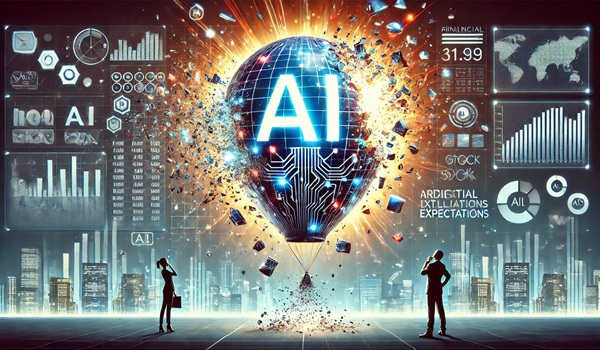By Greg Woolf, AI RegRisk Think Tank
Over the past two years, enthusiasm for AI has repeatedly countered economic headwinds. When the Fed raised rates to fight inflation and markets wobbled, it was AI that kept Wall Street buoyant. But the story is no longer confined to stock charts. Massive capital investments in AI infrastructure are now showing up in GDP, jobs, and the national conversation about technology itself.
Click Here to Learn More About the AI Readiness
Program for Financial & Wealthtech Firms
The Scale of the Buildout
The big four—Microsoft, Amazon, Google, and Meta—are spending nearly $400 billion this year on AI data centers. That’s more than Europe’s defense budget and almost half of U.S. defense spending. By some estimates, AI capital expenditures alone have contributed more to GDP growth this year than consumer spending. In other words, the U.S. is beginning to look like an AI infrastructure economy, powered less by household consumption and more by server farms, GPUs, and cooling towers.
Wall Street’s ROI Moment
This isn’t just a one-sided bet. Wall Street has become more comfortable with the spend because returns are starting to show up. Microsoft tied 39% cloud revenue growth directly to AI. Meta credited AI with supercharging ad efficiency. Even Google, slower to ramp, insists it’s expanding. For investors, the ROI is finally visible.
What about Mainstream Consumers
While Wall Street leans into AI as an economic engine, researchers are asking a broader question: what do Americans themselves think about AI’s role in their lives and jobs? Between April and June of this year, the Civic Health and Institutions Project—a collaboration among Northeastern University, Mass General, Rutgers, Harvard, and the University of Rochester—conducted one of the largest studies of AI attitudes in the country.
Their report, AI Across America: Attitudes on AI Usage, Job Impact, and Federal Regulation, surveyed 21,000 adults across all 50 states. The objective was to move beyond the views of highly enfranchised users—those already steeped in tech—and instead capture a cross-cutting look at mainstream adoption, job expectations, and trust in government to regulate AI effectively.
Main Findings: Usage is Widespread
The results show that AI has already reached a tipping point of mainstream adoption. Half of U.S. adults reported using at least one major AI tool. Almost every state reported usage levels of at least 40%. For a technology that only hit the market a little over two years ago, this level of penetration is unprecedented.
Jobs and Workplace Expectations
Americans are also keenly aware that AI will reshape work. About 60% of respondents expect AI to affect their job—32% predict a major impact, 26% expect a minor one. The strongest expectations came from younger workers (18–29), higher-income earners, and Asian-Americans, with more than 40% of each group saying AI will have a major effect on their jobs. By contrast, 76% of Americans aged 65+ said AI would have no impact—unsurprising given many are retired.
Regulation: Uncertainty with a Lean Toward “Not Enough”
Perhaps the most striking result concerned regulation. Across all 50 states, more Americans worried that government would not regulate AI enough (41%) than those who feared overregulation (27%). Still, a full third admitted they simply didn’t know. That uncertainty suggests that national attitudes are still being formed.
Interestingly, this wasn’t a strictly partisan divide. Democrats and Republicans answered almost identically, a rare sign of consensus in today’s polarized climate. The exception came in demographic cross-tabs: young people were the most skeptical of heavy-handed rules, while Black Americans were the only group where more respondents feared overregulation than underregulation.
Infrastructure vs. Public Ambivalence
The juxtaposition is striking. On one side, the economy is increasingly defined by trillion-dollar companies pouring billions into AI infrastructure—laying digital railroads that may power growth for decades. On the other, the public recognizes AI’s ubiquity but remains undecided about what it means for jobs, opportunity, and governance.
Lessons from History
If history is a guide, the investment cycle may look like a bubble but leave behind assets that fuel future industries. Railroads did. Fiber optics did. AI data centers almost certainly will. The real question is whether we can have the consumer conviction fast enough to match the economic transformation already underway.
The Defining Tension
For now, AI isn’t just an innovation story—it’s an economic story. The servers are humming, the capital is flowing, and the public is still making up their mind. That tension may define not just the next business cycle, but the future of the American economy.
 Greg Woolf is an accomplished innovator and AI strategist with over 20 years of experience in founding and leading AI and data analytics companies. Recognized for his visionary leadership, he has been honored as AI Global IT-CEO of the Year, received the FIMA FinTech Innovation Award, and was a winner of an FDIC Tech Sprint. Currently, he leads the AI Reg-Risk™ Think Tank, advising financial institutions, FinTech companies, and government regulators on leveraging AI within the financial services industry. https://airegrisk.com
Greg Woolf is an accomplished innovator and AI strategist with over 20 years of experience in founding and leading AI and data analytics companies. Recognized for his visionary leadership, he has been honored as AI Global IT-CEO of the Year, received the FIMA FinTech Innovation Award, and was a winner of an FDIC Tech Sprint. Currently, he leads the AI Reg-Risk™ Think Tank, advising financial institutions, FinTech companies, and government regulators on leveraging AI within the financial services industry. https://airegrisk.com







